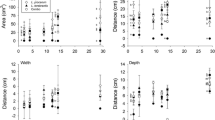Abstract
Melampsorella caryophyllacearum is a heteroecious fungus that produces disease on silver fir resulting in galls that depreciate the value of trees. Currently, little is known about its epidemiology. The purpose of this study was to identify those site or management factors associated with fir broom rust infection. A 29-plot systematic sampling was carried out throughout all silver fir forests in the Spanish Pyrenees. In every sampling plot, we examined each tree for the presence of M. caryophyllacearum galls or witch’s brooms. We differentiated their position as either on the main stem or on the branches of trees. We identified the most susceptible stands by relating a compendium of tree and stand variables with the presence and severity of symptoms. Disease symptoms were observed in 11.8% (95% CI: 5.8–17.9%) of trees. Fir broom rust-infected trees tended to be those of larger diameters. The rust infection was observed in 55.2% (95% CI: 35.7–73.6%) of the stands. We identified a wide range of severities with 5 of 29 stands having more than 30% of trees infected. Fir broom rust appeared to be a widespread disease, although we observed important differences in terms of severity. The presence and severity of the rust in stands was associated with understories composed of more shade tolerant plant species and with longer periods without thinnings. Canopy opening should be experimentally tested as a possible control method.

Similar content being viewed by others
References
Blanco E, Casado MA, Costa M, Escribano R, García-Anton M, Génova M, Gómez-Manzaneque F, Moreno JC, Morla C, Regato P, Sainz-Ollero H (1997) Los bosques ibéricos: Una interpretación geobotánica. Planeta, Barcelona
Boullard B (1979) Rusts, a pathology problem. Forêt Privée 128:36–41
Butin H (1995) Tree diseases and disorders: causes, biology, and control in forest and amenity trees. Oxford University Press, Oxford
Clopper CJ, Pearson ES (1934) The use of confidence or fiducial limits illustrated in the case of the binomial. Biometrika 26:404–413
DGCONA (Dirección General para la Conservación de la Naturaleza) (2001) Segundo Inventario Forestal Nacional. Organismo Autónomo de Parques Nacionales, Madrid, Spain
Ellenberg H, Weber HE, Düll R, Wirth V, Werner W, Paulißen D (1991) Zeigerwerte von Pflanzen in Mitteleuropa. Scripta Geobot 18:1–248 (Translation: Mayor-López M, Gunnemann H (1994) Los valores ecológicos de las plantas vasculares (sin rubus) de Heinz Ellenberg. Universidad de Oviedo Servicio de Publicaciones, Oviedo, Spain)
Kraft G (1884) Zur Lehre von den Durchforstungen, Schlagstellungen und Lichtungshieben, Hanover Germany (Cited in Oliver and Larson (1996)). Oliver CD, Larson BC (1996) Forest stand dynamics. Wiley, New York
Littell RC, Miliken GA, Stroup WW, Wolfinger RD (1996) SAS system for mixed models. SAS Institute Inc, Cary
Maser C, Trappe JM (1984) The seen and unseen world of the fallen tree. USDA Forest Service General Technical Report PNW-164
Merrill W, Wenner NG, Peplinski JD (1993) New host distribution records from Pennsylvania conifers. Plant Dis 77:430–443
Montoya R, López M, Sánchez G, González MR, Jiménez R (1998) La red europea de seguimiento de daños en los bosques (Nivel 1) en España, 1987–1996. Organismo Autónomo de Parques Nacionales, Madrid
Montoya R, Sánchez G, Férnandez J, Noriega AB (2002) La salud de los montes en los Parques Nacionales y Centros Forestales: Una guía para el visitante. Organismo Autónomo de Parques Nacionales, Madrid
Nicolotti G, Cellerino GP, Anselmi N (1995) Distribution and damage caused by Melampsorella caryophyllacearum in Italy. In: Capretti P, Heiniger U, Stephan R (eds) Shoot and foliage diseases in forest trees. Proceedings of a Joint Meeting of the IUFRO Working Parties S2.06.02 and S2.06.04, 6–11 June 1994, Vallombrosa, Firenze, Italy, pp 289–291
Schabenberger O, Pierce FJ (2002) Contemporary statistical models for the plant and soil sciences. CRC Press LLC. Boca Raton
Shigo AL (1967) Successions of organisms in discoloration and decay of wood. Intern Rev For Res 2:237–299
Sinclair WA, Lyon H (2005) Diseases of trees and shrubs, 2nd edn. Cornell University press, Ithaca
Singh P (1978) Broom rusts of balsam fir and black spruce in Newfoundland. Eur J For Pathol 8:25–36
Smith IM, Dunez J, Phillips DH, Lelliott RA, Archer SA (1992) Manual de enfermedades de las plantas. Mundi-Prensa, Madrid
Solla A, Camarero JJ (2006) Spatial patterns and environmental factors affecting the presence of Melampsorella caryophyllacearum infections in an Abies alba forest in NE Spain. For Path 36:165–175
Solla A, Sánchez-Miranda Á, Camarero JJ (2006) Radial-growth and wood anatomical changes in Abies alba infected by Melampsorella caryophyllacearum: a dendroecological assessment of fungal damage. Ann For Sci 63:293–300. doi:10.1051/forest:2006008
Vendramin GG, Degen B, Petit RJ, Anzidei A, Madaghiele A, Ziegenhagen B (1999) High level of variation at Abies alba chloroplast microsatellite loci in Europe. Mol Ecol 8:1117–1126
Acknowledgments
Authors are grateful to the Instituto Nacional de Investigacion y Tecnologia Agraria y Alimentaria (INIA), Spain, project (RTA01-071-C3-1), and to the managing organism of the INTERREG III A, France-Spain, Action S3 of the project SYLVAPYR (I3A-1-57-E) for partially funding this research.
Author information
Authors and Affiliations
Corresponding author
Additional information
Communicated by Rainer Matyssek.
Rights and permissions
About this article
Cite this article
Oliva, J., Colinas, C. Canopy openings may prevent fir broom rust (Melampsorella caryophyllacearum) infections. Eur J Forest Res 126, 507–511 (2007). https://doi.org/10.1007/s10342-007-0172-8
Received:
Revised:
Accepted:
Published:
Issue Date:
DOI: https://doi.org/10.1007/s10342-007-0172-8




